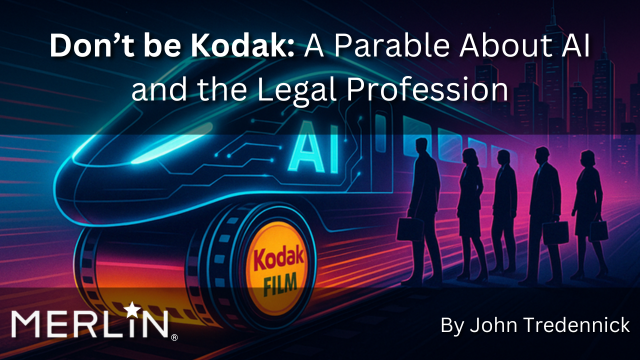
[EDRM Editor’s Note: The opinions and positions are those of John Tredennick.]
I was speaking to Jack, an old friend and senior partner at a national law firm, late one afternoon. Our topic was how GenAI technology could handle a wide variety of litigation tasks in seconds—work that would otherwise require hours of human effort.
Like creating a timeline or a witness examination in seconds, rather than hours or days. Or analyzing thousands of pages of deposition transcripts and medical records for a tenth of the fees manual review might require.
You could see the wheels turning as Jack began to grasp the implications of this new technology, particularly as he watched our GenAI-powered Alchemy platform perform these tasks before his very eyes.
I finished the presentation by showing him a 60-page closing argument for the BP trial which Alchemy created in about an hour.
“Jack, this train is coming, whether we like it or not!”
John Tredennick, Merlin Search Technologies (emphasis in original).
“Your only choice,” I continued, “is to board one of the front cars, where the cushions are soft and the drinks are free. Otherwise, you may find yourself riding in the caboose, or even left on the tracks. There really are no other options.”
After uttering a few words of amazement, Jack blurted out what many would call the quiet part:
“My partners are not going to be happy about what you are doing here. Many are already nervous about what new products like Alchemy will do to their business. You must know this will not be an easy sell.”
I paused thoughtfully. His concern was legitimate—I’ve spent 20+ years in a large law firm and attended countless partner meetings discussing billable hours and their importance to the business. The fear is real and understandable. Yet the reality remains unchanged.
I then shared what I have told others at every level of the legal ecosystem.
“Jack, this train is coming, whether we like it or not!”
“Your only choice,” I continued, “is to board one of the front cars, where the cushions are soft and the drinks are free. Otherwise, you may find yourself riding in the caboose, or even left on the tracks. There really are no other options.”
Jack nodded his understanding, but I could see he was worried about how he might convince his partners to pay heed. After all, mine was an existential warning, one that would not go over well for institutions who charge for services based on how long it takes to do the work. If complex legal work could now be done in minutes rather than days, the entire firm structure might collapse.
As we continued our discussion, I offered this advice:
“Whatever you and the firm decide to do, don’t hide your head in the sand and hope the problem goes away. Find a way to master this new technology and lead the profession into the next era. Develop new skills and better ways to deliver legal services embracing GenAI and all that it brings to a smart legal professional. It may seem a daunting path but it is the only option offering a chance for success.”
I summed it all up in these words: “Whatever you do, don’t be Kodak.”
The Fall of a Film Icon
Many younger colleagues may not realize that before digital cameras, Kodak dominated photography. Their story offers a sobering lesson:
In 2005, Kodak was an industry icon—a Fortune 500 company with $14 billion in revenue and a century-old trusted brand. Seven years of sharply declining revenues later, the company filed for bankruptcy.
Kodak’s leadership saw the digital revolution coming but couldn’t imagine sacrificing their golden goose. Film sales generated 70% of their profits—an addictive revenue stream that blinded executives to the digital revolution that was fast approaching.
John Tredennick, Merlin Search Technologies.
What happened? Kodak’s leadership saw the digital revolution coming but couldn’t imagine sacrificing their golden goose. Film sales generated 70% of their profits—an addictive revenue stream that blinded executives to the digital revolution that was fast approaching. As we all know, digital cameras took over the market, leaving Kodak standing at the station, their warehouses filled with unwanted cameras and film.”
In less than a decade, an American industrial giant disappeared—not because they couldn’t see the train coming, but because they chose to ignore what they saw happening.
The Fujifilm Pivot
While Kodak collapsed, their primary competitor, Fujifilm, faced identical market challenges but chose a radically different path.
In the 1980s, Fujifilm’s leadership recognized the threat of digital photography. Rather than protecting their film business, they prepared for transformation. While Kodak was still dominating the market, Fujifilm began aggressively diversifying:
- They leveraged their chemical expertise to enter the pharmaceutical and cosmetics industries
- They transformed their film knowledge into medical imaging technology
- They invested heavily in digital photography rather than resisting it
- They ruthlessly restructured their organization for the digital age
Today, Fujifilm is a thriving $20+ billion company, while Kodak is a shadow of its former self. Same industry, same technological disruption, vastly different outcomes—all because one company hid in the past while the other embraced the future.
Don’t Wait for Your Kodak Moment
The legal industry now faces a similar trajectory. For law firms, the question isn’t whether this transformation will happen but how they will navigate it. Will they be like Kodak, clinging to an outdated business model until it’s too late? Or will they be like Fujifilm, proactively evolving while they still have the resources and market position to do so?
The signs of transformation are already visible across the legal landscape. Document review work that once required armies of associates is now being handled by AI systems with increasing accuracy and dramatically reduced time. Deposition analysis that previously consumed days of billable hours can now be summarized and extracted in minutes. Contract drafting and review processes that were once lengthy manual tasks are being accelerated through AI-assisted platforms.
Firms that adapt will explore value-based pricing models that decouple revenue from time spent and transform their operations for dramatically greater efficiency.
John Tredennick, Merlin Search Technologies.
Rather than watching your firm slowly slide toward its own Kodak moment, why not embrace the new era of legal practice by creating specialized expertise in AI-powered legal solutions, developing new workflows that integrate AI for enhanced efficiency, and focusing human talent on the truly complex aspects of law that AI cannot handle. Firms that adapt will explore value-based pricing models that decouple revenue from time spent and transform their operations for dramatically greater efficiency.
The train is indeed coming; arguably it’s already here. Some are onboard, others are clambering on. There may not be enough seats for everyone to ride.
My best advice to Jack, his firm and my legal colleagues is: Don’t be Kodak. Don’t be left at the station when the train departs.
Assisted by GAI and LLM Technologies per EDRM GAI and LLM Policy.


